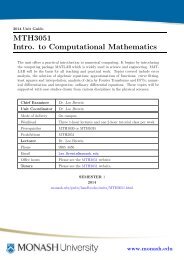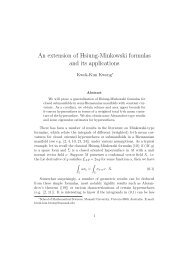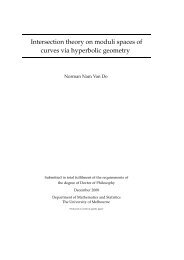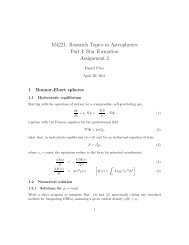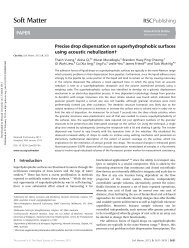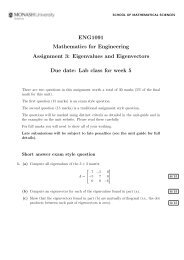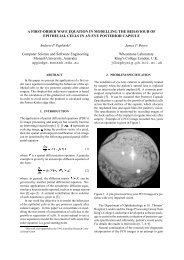MTH3051 Introduction to Computational Mathematics - User Web ...
MTH3051 Introduction to Computational Mathematics - User Web ...
MTH3051 Introduction to Computational Mathematics - User Web ...
Create successful ePaper yourself
Turn your PDF publications into a flip-book with our unique Google optimized e-Paper software.
School of Mathematical Sciences<br />
Monash University<br />
Example 4.4 New<strong>to</strong>n-Raphson with f ′ (x) = 0<br />
Find x such that 0 = f(x) = (x − 1) 2 . Clearly f(x) = 0 and f ′ (x) = 0 at x = 1 so x = 1<br />
is our root. Let’s take the initial guess of x = 0.5. Here is what we get from a naive<br />
application of the New<strong>to</strong>n-Raphson algorithm.<br />
New<strong>to</strong>n-Raphson iterations x n+1 = x n − f n /f n, ′ f(x) = (x − 1) 2<br />
Iteration n Old guess x n New guess x n+1 (x n+1 − 1) 2 ɛ n+1 /ɛ n<br />
0 0.500000000000 2.500e-01<br />
1 0.500000000000 0.750000000000 6.250e-02 5.000e-01<br />
2 0.750000000000 0.875000000000 1.563e-02 5.000e-01<br />
3 0.875000000000 0.937500000000 3.906e-03 5.000e-01<br />
4 0.937500000000 0.968750000000 9.766e-04 5.000e-01<br />
5 0.968750000000 0.984375000000 2.441e-04 5.000e-01<br />
6 0.984375000000 0.992187500000 6.104e-05 5.000e-01<br />
7 0.992187500000 0.996093750000 1.526e-05 5.000e-01<br />
8 0.996093750000 0.998046875000 3.815e-06 5.000e-01<br />
9 0.998046875000 0.999023437500 9.537e-07 5.000e-01<br />
10 0.999023437500 0.999511718750 2.384e-07 5.000e-01<br />
The iteration do converge, but not as fast as in the previous example. Notice that<br />
ɛ n+1 /ɛ n remains constant. That is, each iteration reduces the error by a constant fac<strong>to</strong>r<br />
(in this case 1/2). This is typical of New<strong>to</strong>n-Raphson iteration when x is a root of both<br />
f(x) = 0 and f ′ (x) = 0.<br />
4.3.1 Some notation.<br />
◮ Simple root: When f(x) = 0 and f ′ (x) ≠ 0.<br />
◮ Double root: When f(x) = 0, f ′ (x) = 0 and f ′′ (x) ≠ 0.<br />
◮ Root of order m:<br />
When f(x) = 0 and all derivatives up <strong>to</strong> f (m−1) (x) are<br />
zero at x while f (m) (x) ≠ 0.<br />
16-Feb-2014 48



